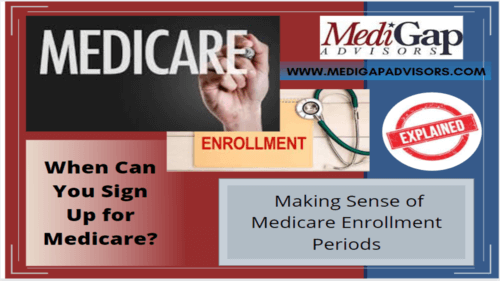During Medicare enrollment periods, Medicare Part A and Part B are “automatic” for most people, but it actually gets a lot more complicated than that!
Most people know that turning 65 years old means enrolling in Medicare. But between Part A, Part B, Medigap, and Medicare Advantage, making sense of all the different enrollment periods is a lot more complicated than it needs to be.

This guide will examine the four different enrollment periods to know about when it comes to Medicare. At the end, we answer some of the most frequently asked questions about signing up for Medicare, and offer a few expert tips on top of that.
TIP: Add this page to a bookmarks folder labeled “Medicare”. We will keep it updated with all the new information and updates year-after-year.
Are you here because you’re ready to enroll? Click here to schedule a no-cost enrollment consultation with a Personal Benefits Manager.
Answered: When Can I Sign Up for Medicare?
The first time you can sign up for Medicare is during a seven-month window around the month you turn 65. This is known as the initial enrollment period, and begins 3 months before your birthday.
If you are already collecting Social Security, then you will be enrolled in Medicare Part A and Part B automatically. If you’re still working or not collecting Social Security, you will need to manually enroll when the time comes (see the ‘General Enrollment Period’ section below).
Refresher: The 4 Types of Medicare
Not sure which type of Medicare you need? Here is a quick refresher:
- Medicare Part A / Hospital Insurance: Protects against ER, hospital, emergency care, and any hospice or home health care required as a result. For most people, Part A has a $0 premium and enrollment is automatic.
- Medicare Part B / Outpatient Care Insurance: Protects against outpatient hospital care, physician services, medical equipment, and more. Most people will pay $274 per month for part B, regardless of any other Medicare plans in place. Part B enrollment is also usually automatic.
- Medicare Part C / Medicare Advantage: Part C is a private form of Medicare. Enrollees who switch to a Medicare Advantage plan do so for lower monthly prices and more comprehensive coverage, among other reasons.
- Medicare Part D / Prescription Drug Plans: Part D or “PDP” plans help pay for prescription drugs and medication not covered by Original Medicare. Most Part C plans also include Part D coverage.
In addition to the 4 main types of Medicare, there are also Medicare Supplement Plans, or Medigap. These standalone plans are designed to be added-on to Original Medicare for things like dental, vision, and long-term care.
READ MORE: Check out our companion guide, The 4 Different Types of Medicare, where we dive much deeper into the difference between Medicare plans.
Get a Free Medicare Supplement Quote
Medicare Enrollment Periods Explained
Here are the key enrollment periods that all Medicare enrollees should know about:
Initial Enrollment Period (IEP)
The Initial Enrollment Period begins three months before a person’s 65th birthday, and extends for seven months. During this period, anyone who is already collecting Social Security will be automatically enrolled in Part A and Part B.
Anyone who does not get enrolled in Medicare during the Initial Enrollment Period must do so through the General Enrollment Period (see below).
- Who it’s for: Individuals who are turning 65 and signing up for Medicare for the first time.
- When it is: 7-month window around your 65th birthday.
Medicare Supplement Open Enrollment
Anyone who is signing up for Part A and Part B during IEP also has the opportunity to enroll in a supplemental Medigap plan around the same time.
- Who it’s for: First-time Medicare enrollees who want to supplement their coverage with a standalone Medigap plan.
- When it is: A six-month period that begins on the first day of the month you turn 65. (Medicare Part B enrollment is required.
General Enrollment Period (GEP)
The General Enrollment Period is for anyone who didn’t sign up for Medicare during their IEP. In most cases, these are people who are either still working or put off Social Security benefits.
If you start collecting Social Security later than 65, you can use the next General Enrollment Period to sign up.
- Who it’s for: People who didn’t sign up for Medicare when they were first eligible.
- When it is: January 1st – March 31st every year, or a July 1st effective coverage date.
Special Enrollment Period (SEP)
The Medicare Special Enrollment Period allows individuals experiencing special life circumstances to make changes to their Medicare, Medicare Advantage, or PDP plans.
- Who it’s for: Anyone who:
- Has moved to a new address that has different plan options
- Has recently moved back to the U.S. after being abroad
- Has recently moved into or out of a skilled nursing facility or long-term care hospital
- Has been released from jail
- Is no longer eligible for Medicaid
- Is no longer covered by an employer or union health plan
- Was enrolled in a plan that has either been terminated by the insurer or sanctioned by Medicare.
- When it is: Most SEPs come with a 2-month window from the qualifying life event.
Annual Open Enrollment Period (AEP)
Annual Enrollment is an opportunity for all current Medicare enrollees to make changes to their coverage. AEP is totally optional; If you don’t need to make changes to your coverage, then you don’t need to do anything.
- Who it’s for: Anyone who:
- Wants to switch from Original Medicare to Medicare Advantage
- Wants to switch from Medicare Advantage back to Original Medicare
- Wants to switch from one Medicare Advantage plan to different one
- Need to join or drop a Part D prescription drug plan
- When it is: October 15th – December 7th every year, for an effective coverage date of January 1st of the new year.
Get a Free Medicare Advantage Quote
Medicare Enrollment Periods Frequently Asked Questions [FAQs]
Q: When can I sign up for Medicare?
A: The first time you can sign up for Medicare is when you are about to turn 65 and have begun to collect Social Security benefits.
Q: When is the best time to sign up for Medicare Advantage?
A: Because they can have lower monthly rates and more comprehensive options, many people choose to enroll in Medicare Advantage during their Initial Enrollment Period. It’s also possible to switch to Medicare Advantage at a later date as long as it’s during the Annual Enrollment Period.
Q: When can I sign up for Part D?
A: You can sign up for a Part D plan during the Initial Enrollment Period when you’re first turning 65. Signing up for Part D anytime after this could lead to a penalty in the form of higher premiums.
Q: What is the enrollment period for Medicare Part B?
A: Enrollment for Medicare Part A and B begins three months before your 65th birthday. If you’re not yet collecting Social Security benefits, you can delay enrollment in Part B until you’re ready or no longer working.
Meet Your Real-Life, No-Cost Medicare Consultant
When you sign up for Medicare through MediGap Advisors, you’re paired with an expert Personal Benefits Manager to walk you through the process. They’ll start by getting an understanding of your medical needs and financial goals, then pair you with the Medicare plan that works best.
Ready to enroll? Click here to get your free consultation, or just give us a call at 800-913-3416.

Mike Montes is a Personal Benefits Manager at MediGap Advisors. Mike has a passion for bringing clarity to those confused about Medicare. He is an authority on Medicare, Medicare supplement plans, Medicare Advantage plans, and Part D prescription drug plans. Read more about Mike on his Bio page.
